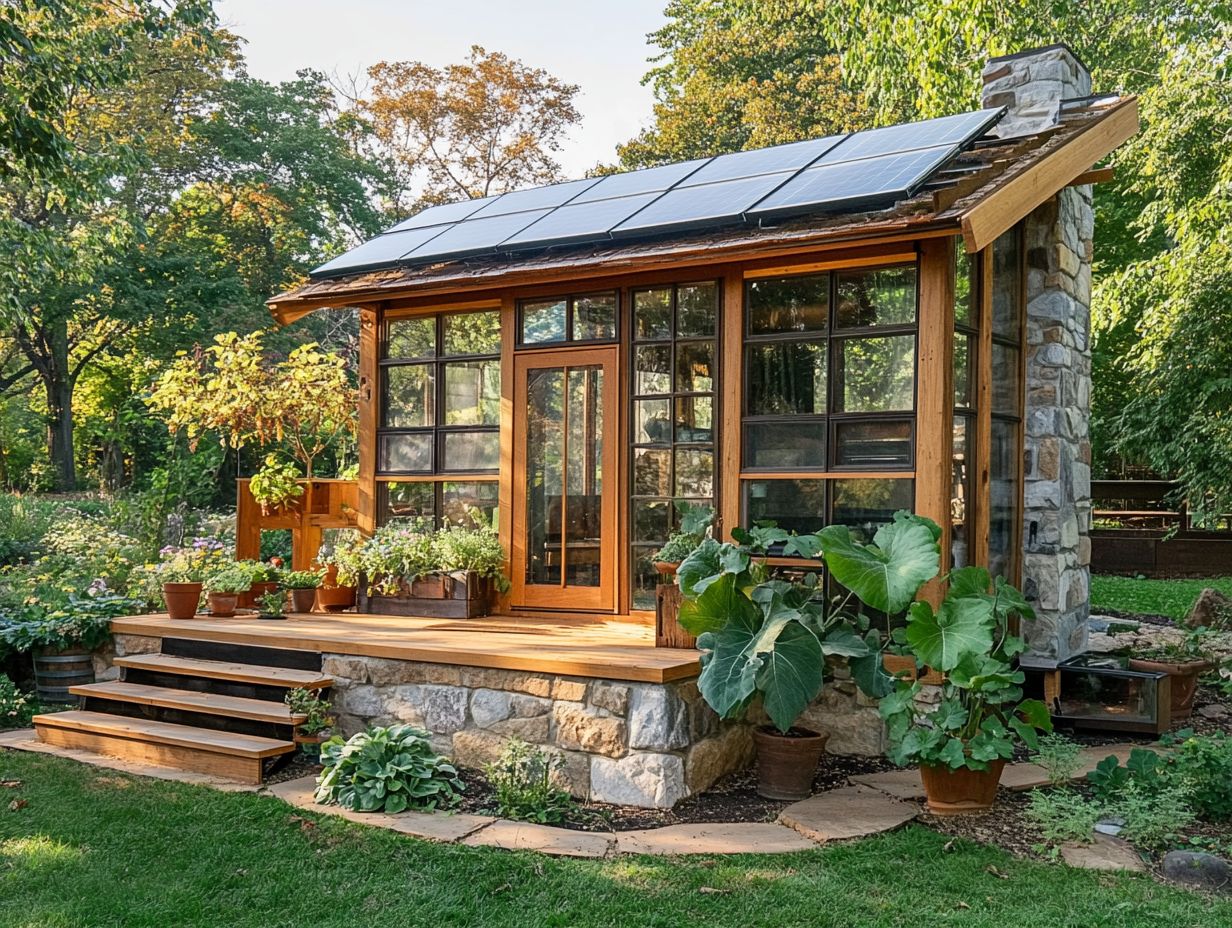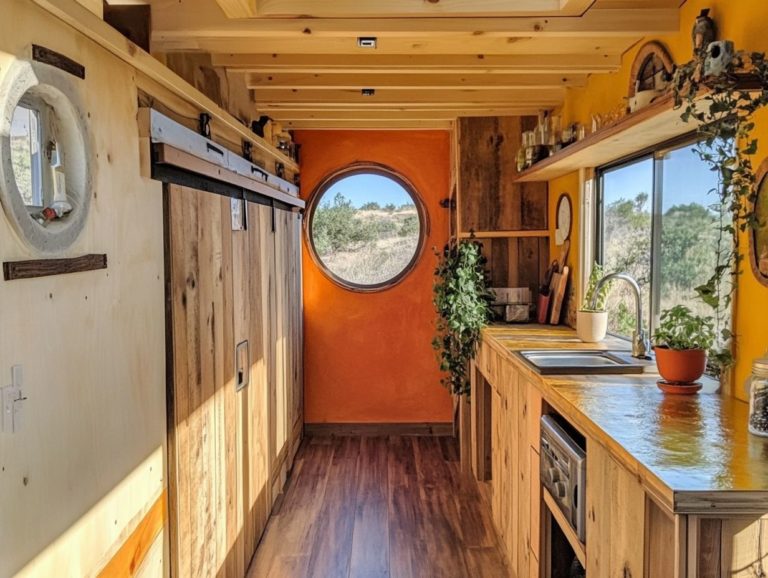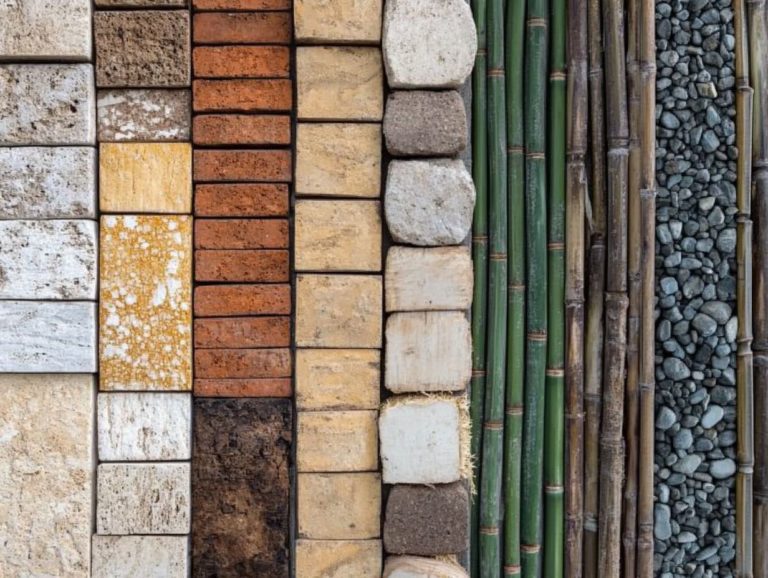Creating an Eco-Friendly Tiny Home with Local Materials
Eco-friendly tiny homes are becoming popular. They help you live sustainably and reduce your impact on the environment.
This article explores the benefits of using local materials. It highlights how local sourcing reduces environmental impact while also offering significant cost savings.
You ll find guidance on selecting the right materials, incorporating sustainable design principles, and following a step-by-step process to build your dream home.
You ll also find tips to maintain your eco-friendly sanctuary along with insights into the promising future of tiny living. Jump in and explore how you can start living a greener lifestyle today!
Contents [hide]
- Key Takeaways:
- Benefits of Using Local Materials
- Choosing the Right Local Materials
- Designing an Eco-Friendly Tiny Home
- Building an Eco-Friendly Tiny Home
- Maintaining an Eco-Friendly Tiny Home
- Frequently Asked Questions
- What is an eco-friendly tiny home?
- Why should I consider using local materials for my tiny home?
- What are some examples of local materials that can be used for an eco-friendly tiny home?
- How can I ensure that my tiny home is energy-efficient?
- Are there any downsides to using local materials for my tiny home?
- Can I still have a stylish and comfortable tiny home while using local materials?
Key Takeaways:

- Incorporating local materials in building a tiny home benefits both the environment and your wallet by reducing carbon emissions and saving on costs.
- When choosing materials, consider sustainability, durability, and availability in your local area.
- Adopting sustainable design principles and maintenance habits can ensure an eco-friendly tiny home for the future.
What is an Eco-Friendly Tiny Home?
Eco-friendly tiny homes are innovative structures crafted with sustainability at their core. They use sustainable materials for construction while promoting energy efficiency, which means using less energy to provide the same service, like keeping your home warm.
These homes embody the essence of the tiny house movement. Resourceful builders focus on minimizing environmental impact while maximizing functionality and comfort.
By integrating features such as natural building techniques and eco-friendly insulation, these homes not only reduce waste but also encourage a lifestyle deeply rooted in environmental consciousness.
This movement champions the idea of living simply and lightly. Eco-friendly tiny homes often incorporate reclaimed wood and recycled materials to lessen the carbon footprint of new constructions.
Many of these tiny homes come equipped with solar panels, rainwater harvesting systems, and efficient appliances, all contributing to their energy-efficient designs.
For those seeking to embrace minimalist living while positively impacting the planet, eco-friendly tiny homes offer an inspiring solution that aligns beautifully with a sustainable future.
Benefits of Using Local Materials
Embracing local materials in construction cuts down on transportation emissions. It has a profound impact on the local economy and promotes sustainable building practices.
This approach yields a wealth of environmental benefits, such as reducing waste and nurturing a connection to the cultural heritage of the community.
By choosing locally sourced materials, you can craft structures that harmonize with their surroundings while minimizing your carbon footprint.
Environmental Impact
Building eco-friendly tiny homes has a big positive impact on the environment. These dwellings are meticulously crafted to minimize waste and champion sustainable living.
Resourceful builders employ eco-friendly techniques, carefully selecting every component from insulation materials to energy-efficient appliances based on its minimal environmental footprint.
This deliberate selection process curtails the waste generated during construction and cultivates a lifestyle prioritizing conservation.
By incorporating features such as solar panels and water-saving fixtures, these homes significantly reduce dependence on nonrenewable resources.
Builders often opt for recycled or reclaimed materials. They transform what could easily be considered waste into beautiful, functional elements that enhance the charm of the space.
As a result, you can enjoy lower utility bills while making a positive contribution to a healthier planet, showcasing how eco-friendly tiny homes can serve as a model for future sustainable development.
Ready to make a change? Start your journey towards an eco-friendly tiny home today!
Cost Savings
One of the standout financial advantages of building eco-friendly tiny homes is the significant cost savings tied to energy efficiency.
Use sustainable materials and energy-efficient systems, like solar panels and water recycling, to slash your utility bills and maintenance costs.
Beyond just reducing those utility costs, your initial investment in energy-efficient appliances and water conservation methods think low-flow fixtures can lead to impressive long-term savings.
These thoughtful tweaks not only trim your monthly expenses but also elevate the overall sustainability of your living space.
When you choose sustainable materials, you’re investing in longevity and reduced upkeep.
Ultimately, embracing eco-friendly tiny homes is a savvy financial move, balancing initial costs with a future of lower expenses and a smaller carbon footprint.
Choosing the Right Local Materials

Choosing the right local materials can transform your eco-friendly tiny home! It significantly impacts the overall sustainability of your project.
Consider factors like availability, environmental impact, and compatibility with sustainable construction practices.
This approach ensures that materials such as reclaimed wood and eco-friendly insulation are utilized to their fullest potential, enhancing both the quality and sustainability of your new space.
Factors to Consider
When selecting local materials for your eco-friendly tiny home, keep several essential factors in mind to ensure sustainability and efficiency.
Consider each material’s lifespan, environmental impact, and how they align with sustainable practices, such as reusing materials or utilizing products with a low carbon footprint.
Evaluating the durability of these materials is crucial; you want them to withstand local weather conditions over time.
Choosing local materials that require minimal processing cuts down on energy consumption and bolsters the economic stability of your community.
Understanding how these materials complement your tiny home s design and function is vital for achieving a harmonious balance with nature.
Look into the origins of the materials, opting for those that are sustainably harvested or produced using eco-friendly practices.
This holistic approach deepens your connection with the environment and aligns perfectly with your mission of creating a truly sustainable living space.
Designing an Eco-Friendly Tiny Home
Designing an eco-friendly tiny home requires embracing sustainable design principles that prioritize energy efficiency and minimize environmental impact.
Integrating features like passive solar design and using sustainable materials helps craft a living space that meets practical needs while cultivating a profound respect for nature.
Throughout the design process, focus on maximizing resource efficiency while ensuring that the home remains comfortable and functional.
Sustainable Design Principles
Sustainable design principles form the bedrock of eco-friendly tiny homes, highlighting the importance of using natural building materials and energy-efficient appliances.
By incorporating elements like thermal mass materials that store heat and reclaimed wood, you can significantly boost your home’s energy performance.
Create a comfortable living space that minimizes environmental impact.
These principles champion passive solar design, enabling you to harness the sun s energy for heating and cooling, thus reducing your reliance on nonrenewable resources.
Thoughtfully place windows for optimal natural light while framing stunning views of your surroundings, deepening your connection with nature.
Consider integrating rainwater harvesting systems, which promote water conservation and enhance your sustainability efforts.
Embracing these innovative approaches allows eco-friendly tiny homes to function efficiently and stand as exemplars of modern living, blending comfort with ecological responsibility.
Start planning your eco-friendly tiny home today!
Building an Eco-Friendly Tiny Home
Creating an eco-friendly tiny home takes careful planning. It places sustainability at the forefront of every step, from the initial blueprint to the final embellishments.
Throughout this process, you’ll embrace techniques like utilizing reclaimed wood, selecting energy-efficient appliances, and implementing innovative waste reduction strategies. The result is a home that is not only functional but also a testament to environmentally responsible living.
Step-by-Step Process

Building an eco-friendly tiny home requires a careful process. Focus on materials and methods that save energy and are good for the planet.
You ll want to choose energy-efficient appliances and implement water conservation techniques. Thoughtfully planning your layout will maximize natural light and ventilation.
Prioritizing energy-efficient appliances cuts down on electricity consumption and helps reduce your utility bills, making your tiny home more economical over time. Options like LED lighting can significantly enhance energy savings.
Installing low-flow fixtures in your kitchen and bathroom is essential for conserving water. This straightforward adjustment can lead to a significant decrease in water usage, which is crucial for preserving our precious resources.
A well-designed layout that embraces natural light minimizes the need for artificial lighting during the day and enhances airflow. This ultimately improves your indoor air quality. You should also consider integrating passive solar techniques for extra benefits.
Each of these measures contributes to your personal comfort while also promoting a holistic approach to eco-friendly construction. This allows you to live in harmony with the environment through practices like waste reduction and utilizing reclaimed wood.
Maintaining an Eco-Friendly Tiny Home
Caring for your eco-friendly tiny home is an exciting journey! It s a commitment to sustainable living that elevates both your comfort and your environmental responsibility.
This involves regular attention to essential systems, such as the greywater system a system that recycles water from sinks and showers and composting toilet. By ensuring these components operate efficiently, you effectively minimize waste and resource consumption, creating a harmonious balance between modern living and ecological mindfulness.
Tips for Sustainable Living
Adopting sustainable living practices is crucial for unlocking the full potential of your eco-friendly tiny home. There are several effective strategies you should consider:
- Emphasize waste reduction, energy efficiency, and water conservation techniques.
- Embrace zero-waste strategies, such as composting food scraps and opting for reusable containers, to dramatically reduce your contribution to landfills.
- Switch to energy-efficient appliances and LED lighting to slash your electricity consumption and keep those monthly utility bills in check.
- Incorporate innovative water conservation methods like installing low-flow fixtures and rainwater harvesting systems to promote responsible water usage and enhance your home’s overall sustainability.
These practices not only serve the planet but also foster a sense of community, inspiring others to embrace eco-friendly habits and join the movement toward a greener future, as seen in projects by Rocky Mountain Tiny Houses and Great Wall of China.
The Future of Eco-Friendly Tiny Homes
The future of eco-friendly tiny homes is looking incredibly promising. Advancements in sustainable materials and construction practices continue to evolve alongside the tiny house movement. With a growing emphasis on energy efficiency and environmental stewardship, these homes are set to redefine modern living in a way that aligns with your values.
Innovations like bamboo flooring, recycled metals, and non-toxic insulation are becoming the norm. These materials allow you to live comfortably without compromising your commitment to sustainability. Resourceful builders are embracing modular designs, which means buildings made from pre-fabricated parts, and smart building techniques that minimize waste and cut costs. This shift is influencing broader housing trends, encouraging urban planners and traditional developers to explore more minimalist designs that prioritize green spaces and community over mere square footage. For those interested in tiny homes, adopting sustainable design practices for tiny houses can further enhance eco-friendly living.
As the tiny house phenomenon gathers momentum, it reshapes perceptions of homeownership and sustainability. This ultimately guides you toward a more environmentally conscious lifestyle while embracing the tiny house movement.
Frequently Asked Questions
What is an eco-friendly tiny home?

An eco-friendly tiny home is a small living space designed with sustainability and environmental impact in mind. It uses natural, non-toxic materials and incorporates energy-efficient features to minimize its carbon footprint.
Why should I consider using local materials for my tiny home?
Using local materials for your tiny home offers several benefits. It reduces transportation costs and emissions, supports the local economy, and promotes the use of sustainable resources. Local materials are often cheaper and readily available.
What are some examples of local materials that can be used for an eco-friendly tiny home?
Examples of local materials include reclaimed wood, straw bales, adobe, cob, and bamboo. These materials are renewable, biodegradable, and have a low environmental impact.
How can I ensure that my tiny home is energy-efficient?
To make your tiny home energy-efficient, incorporate features like solar panels, a rainwater harvesting system, and energy-efficient appliances. Ensure your home is well insulated and designed to maximize natural light and ventilation.
Are there any downsides to using local materials for my tiny home?
While using local materials has many benefits, there are potential downsides. These may include limited availability of certain materials, a longer building process, and the need for specialized knowledge or skills to work with specific materials.
Can I still have a stylish and comfortable tiny home while using local materials?
Absolutely! Using local materials does not mean sacrificing style or comfort. Many creative ways exist to incorporate local materials into your tiny home design, creating a beautiful and functional living space.
Join us in shaping the future of sustainable living today!






